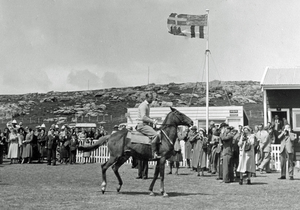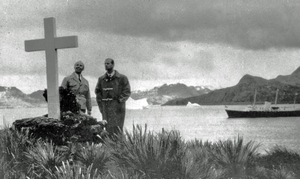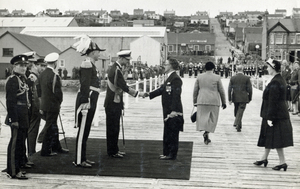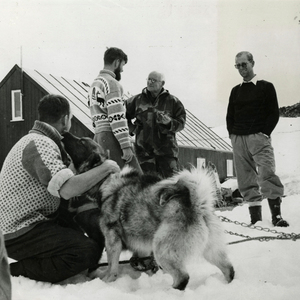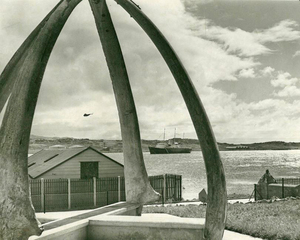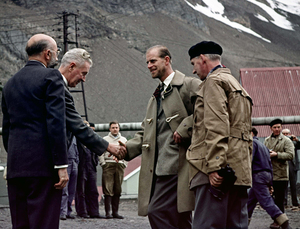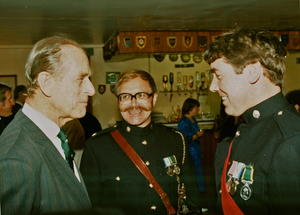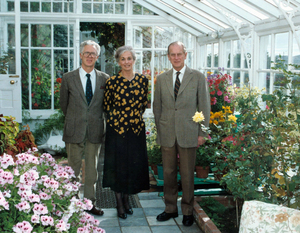EDINBURGH, The PRINCE PHILIP
1921 - 2021 from Greece (also England)
Duke of, Royal visitor, was born on 10 June, 1921, on the Greek island of Corfu, the fifth child and only son of Prince and Princess Andrew of Greece and Denmark. After attending kindergarten school in Paris, he was educated at Cheam preparatory school in England, Salem in south Germany and Gordonstoun in Scotland.
He entered the Royal Naval College, Dartmouth in 1939 before being commissioned into the Royal Navy. During World War II he served in the Indian Ocean, the Mediterranean, the North Sea, the Pacific Ocean and Japan.
Early in 1947 he renounced his Royal title and became a British subject in order to continue his career in the Royal Navy as Lieutenant Philip Mountbatten. On his marriage to HRH The Princess Elizabeth on 20 November 1947 he was created Duke of Edinburgh with the prefix of His Royal Highness. He continued his naval career, reaching the rank of commander, until it came to an end with the death of King George VI in 1952 and the accession of Queen Elizabeth II.
The Queen and The Duke of Edinburgh have four children: Charles, Prince of Wales (b1948), Anne, Princess Royal (b1950), Andrew, Duke of York (b1960) and Edward, Earl of Wessex (b1964). They have seven grandchildren.
After opening the 1956 Olympic Games in Melbourne, the Duke of Edinburgh left Australia on 11 December and sailed from New Zealand on 17 December in HM Yacht Britannia. He travelled home through the South Atlantic visiting several FIDS bases between 1 and 4 January 1957, the Falkland Islands between 7 and 9 January and South Georgia on 12 January.
On 31 December Governor Sir Raynor ARTHUR was flown by helicopter from HMS Protector to the whale factory ship Southern Harvester which the Duke was visiting. Returning from Southern Harvester the party were transferred again by fishing basket from the whale catcher Sondra which came alongside Britannia, using a 50 foot sperm whale as a fender.
The Duke had the roughest ride as the whaler rolled away just as his basket touched down on the Yacht, but the Bosun kept his head and tipped HRH unceremoniously out onto the deck before the basket was dragged away. On this day, New Year's Eve, Britannia had crossed the Antarctic Circle at breakfast time and every member of the crew received a Red Nose certificate which was reproduced from a lino cut, designed and made by the artist Edward Seago, who was a guest onboard, and Prince Philip. It was a memorable day for the Duke's two secretaries who were the first British women to cross the Antarctic Circle.
From 1 to 4 January the Prince visited the Falkland Islands Dependencies bases in the Antarctic, enjoying for the most part excellent weather.
After a tranquil crossing of Drake Passage, Britannia anchored in Stanley harbour at 9 am on Monday 7 January and the Duke, wearing naval uniform and sporting a fair beard which he had been growing since leaving New Zealand, landed by barge at the Public Jetty. Presentations were made by Governor Arthur, Prince Philip inspected a Guard of Honour and walked past the Boys' Brigade and Girls' Life-Brigade on parade and through lines of schoolchildren.
After a short stop at Government House he drove in the Governor's London taxicab to the Town Hall, where he replied to an Address of Welcome presented by Les HARDY, the Senior Elected Member of LegCo. After a change of clothes at Government House, Prince Philip went to the Racecourse for five races, the highlight of which was the Sailors' Race in which HRH finished first on a horse which had never previously won.[But see editorial comment (1) below] As he passed the post the Royal Yacht band played All the Nice Girls Love a Sailor.
Following lunch at Government House he visited the Hospital, Nurses' Home and the Infants' School. Later he arrived at Sapper Hill to see peat cutting and a shooting match between a naval team and one from the Islands. At the Gymnasium he inspected wool, examined horse gear and saw work by spinners, weavers and dyers before planting a tree at Arch Green and visiting the Cathedral.
He then returned to Britannia where he gave a dinner party and later returned to the Town Hall to present prizes to the winners of the various sports and races held over the last two days. The prize-giving was followed by a lively and energetic Ball with music provided by the Royal Yacht band. Prince Philip spent the night at Government House.
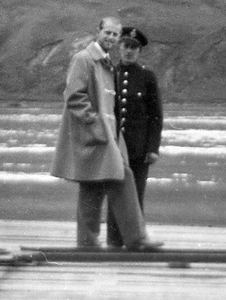
HRH Duke of Edinburgh with Basil ...
On the morning of Tuesday, 8 January HRH made a 70 minute flight in a FIGAS Beaver seaplane. He flew over the wreck of the SS Great Britain, and over Port Louis (the first settlement), Darwin School, Goose Green and Fitzroy before returning to Stanley. Later he visited the Racecourse for an exhibition by sheep dogs and also the Meteorological Station. He held an evening reception in Britannia for 172 people before the Royal Yacht sailed for West Falkland .
On Wednesday, 9 January Britannia anchored off Fox Bay and HRH went ashore to see the general set-up at Fox Bay East where drafting for shearing was in progress. He then visited the Settlement's new recreation centre, the Government wireless station, the power station and the surgery. After smoko at the house of the manager, Wick CLEMENT, Prince Philip visited the woolshed to see shearing and baling, returning to a lunch party in Britannia, before sailing for South Georgia.
At 9 am on 12 January Britannia anchored in Leith Harbour, South Georgia, amid magnificent Antarctic scenery on a lovely sunny day. The Duke of Edinburgh and his party went ashore and toured the Salvesen whaling factory before embarking in the whale catcher Southern Jester (Captain and Master Gunner Nochart NILSEN) for the twenty mile run down the coast to Grytviken, the Pesca station and factory. On the way an old packing case was thrown into the sea and the gunner demonstrated his skill and the gun's capabilities by blowing it to bits at a range of 70 yards. Nilsen, when asked if it was a case of whisky he had fired at, replied 'If it had been I'd have missed'.
At Grytviken His Royal Highness re-joined Britannia and entertained a small party to lunch. Then he went ashore to visit the government station at King Edward Point and saw the Post Office-cum-Customs office, the Radio and the Met Station before walking along the beach to the headland where the plain white cross in memory of Sir Ernest SHACKLETON stands. He watched two fin whales being flensed in the factory and then visited Shackleton's grave in the cemetery.
When Prince Philip returned on board, Britannia sailed at high speed to the Bay of Isles where he landed close to the large King and Gentoo Penguin rookeries and spent some time watching these splendid birds. After dark the Royal Yacht sailed for Gough Island.
Prince Philip sent the following message to the Governor:
As I leave the Falkland Islands and the Dependencies I want you to know how much I have enjoyed the last ten days and the many interesting things I have seen in these Islands.
Please thank the Falkland Islands Legislative Council for their very kind message of farewell on my departure and I would be most grateful if you would express my gratitude and appreciation to all the people who had a hand in making my visit such a pleasant and enjoyable experience, to all the people of the Falkland Islands for their welcome, the leaders and members of the FIDS bases and the whaling companies of South Georgia. I send you all my very best wishes for a happy and prosperous future. Philip
After the 1982 conflict, the Duke of Edinburgh visited the Falkland Islands for a second time between 8 and 13 March, 1991.
He carried out a very full civil and military programme throughout his visit but was also able to include a fishing expedition at Chartres on West Falkland and wildlife viewing on Carcass and Pebble Islands.
The British Antarctic Territory, the Falkland Islands and South Georgia all used scenes from the 1957 royal visit in the stamps they issued in 1977 to celebrate the Queen and Prince Philip's Silver Wedding.
Editorial comment:
(1) Patrick Watts MBE commented on horse racing for Falklands Radio for many years. He notes that 'I respectfully correct one small error in connection with his [Prince Philip] success while winning the Sailor's Race on an imported Chilean mare called Itata. It has been wrongly stated that that HRH finished first on a horse Itata which had never previously won ... Itata was owned by Les HARDY OBE BEM ... at the 1955 annual Christmas sports meeting in Stanley, Itata won the West Falkland Plate ridden by the legendary Joe Butler ... and later also took the Port Louis Plate with the same jockey in the saddle'.
(2) A photograph album, containing twenty-one photographs, of the visit of Prince Philip to the Falklands, was produced. The album was bound in a pebbled red cloth with gold gilt lettering stamped to the front; the page albums are thick black paper with tissue guards. The photographs each measure 210mm x 160mm and are matte silver gelatin prints. The subject matter for the photographs all surround Prince Philip, the Duke of Edinburgh, on his trip to the Falkland Islands Dependencies bases in the Antarctic in early January. The album was created to commemorate Prince Philip's visit to the Falkland Islands in early January of 1957. After opening the 1956 Olympic Games in Melbourne, Prince Philip left Australia on December 11th and sailed from New Zealand on December 17th in the HM Yacht Britannia. He travelled home through the South Atlantic, visiting several FIDS bases between the 1st and 4th of January, 1957, the Falkland Islands between the 7th and 9th of January and South Georgia on January 12th. A limited number of the albums were produced - the first copy is now lodged in the Falkland Islands Museum.
(3) The Falkland Islands Government (FIG) announced in a statement “with deep sadness” that the FIG “has today learned of the death of His Royal Highness Prince Philip, Duke of Edinburgh.” In tribute to the Prince, the Falklands will stage a 21-gun salute on Saturday at noon, followed by a short parade. “During his decades of public duty, the Falkland Islands was pleased to twice welcome the Duke of Edinburgh to our shores in 1957 and 1991. On both occasions, Islanders were struck by his genuine interest in our people, our home and our history,” Mark Pollard, Chair of the Legislative Assembly, stated “On behalf of the people of the Falkland Islands, we wish to express our heartfelt sympathies for Her Majesty the Queen and the wider Royal family at this sorrowful time. We have a deep and lasting affection for the Duke of Edinburgh, who wholeheartedly engaged with our community – young and old – during his time in the Islands. Whether trout fishing in Chartres or taking part in our Boxing Day horse races, his enthusiasm for our traditions and way of life is something that has positively impacted on generations of Falkland Islanders and will never be forgotten.”
HRH The Prince Philip, the Duke of Edinburgh, died on 9 April 2021, at Windsor Castle, aged 99 years.
See: Images 666 and 1462
External links
See: Prince Philip in the Antarctic (Pathe News - YouTube video)
See: Prince Philip visits the Falkland Islands 1991 (FITV You Tube video)
References
Benjamin Jaffray; The visit of HRH The Duke of Edinburgh to the Falkland Islands in 1957; Falklands Islands Journal ; 2020
Comments
Revisions
May 2019 Two photographs added
July 2019 Two additional photographs added
August 2019 External link added
April 2020 One additional image added
June 2020 Two additional photographs added
September 2020 One reference added
April 2021 Text amended; one additional photograph added; two internal links added
May 2021 One additional photograph added; two editorial comments added; two additional external link added
